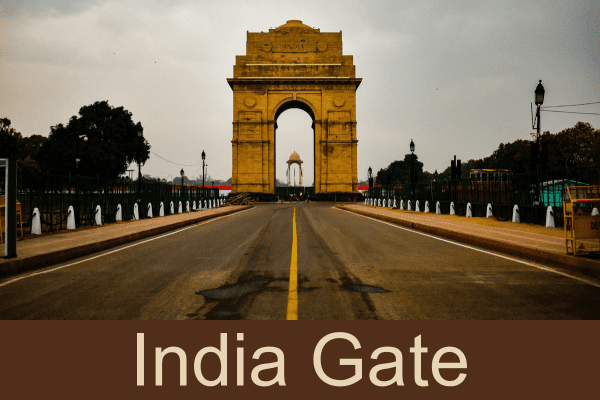In the heart of New Delhi stands one of the most iconic landmarks of India—India Gate, a majestic arched monument that embodies valor, sacrifice, and patriotism. Rising to a height of 42 meters, this solemn memorial tells the story of thousands of Indian soldiers who laid down their lives during World War I, making it one of the most powerful national symbols of remembrance and honor.

🏛️ A Monument of Memory
Located just beyond the Secretariat complex and at the eastern end of Rajpath, India Gate commands attention with its grand, buff-colored sandstone structure. Designed by Sir Edwin Lutyens, the master architect of British colonial Delhi, the monument was originally conceived as the All India War Memorial. Its foundation stone was laid on February 10, 1921, by the Duke of Connaught, a senior member of the British royal family.
The monument was built to honor the memory of over 70,000 Indian soldiers who lost their lives fighting for the British Empire during World War I and the Third Anglo-Afghan War. Though they fought under colonial command, their sacrifice forms an indelible chapter in India’s military history.
🕊️ Names Etched in Stone
As you walk closer to the arch, you’ll notice that the walls of the monument are inscribed with the names of more than 13,000 martyrs. These names, carved into the sandstone, are a lasting tribute and a reminder of the human cost of war. The inscriptions are not just names—they are echoes of bravery, courage, and loss, reminding us of those who gave their today for our tomorrow.
🔥 The Eternal Flame – Amar Jawan Jyoti
At the base of the monument, beneath the archway, lies one of India’s most sacred sites—the Amar Jawan Jyoti, or “Flame of the Immortal Soldier.” This structure was added after the 1971 Indo-Pak war and serves as a memorial to the unknown soldiers who died in service of the nation.
The design is striking in its symbolism: a reversed rifle, capped with a soldier’s helmet, rests atop a black marble pedestal. An eternal flame burns beside it, representing the undying spirit and eternal vigilance of the Indian armed forces. This flame is kept alive 24/7, regardless of weather or time, and is guarded by soldiers from all branches of the military.
Each year, on Republic Day (26th January), the Prime Minister of India lays a wreath at the Amar Jawan Jyoti to honor the martyrs, a ceremony marked by solemnity and national pride.
🚫 Access and Preservation
At one point in time, visitors could climb a flight of stairs to the top of the India Gate, using it as a vantage point to admire the surrounding cityscape or click photographs. However, with rising concerns about safety and preservation, public access to the upper part of the structure has been closed off.
The lawns surrounding the monument remain open and are a popular picnic and relaxation spot for families, tourists, and locals alike. Especially in the evenings, India Gate becomes a hub of activity—lit up beautifully and surrounded by food vendors, music, and laughter.
🌸 A Place for Reflection
Though always buzzing with life, India Gate is also a place of deep reflection. It encourages us to pause, read the names, watch the eternal flame, and remember the incredible human sacrifice that continues to shape our nation’s destiny. The monument may have colonial roots, but it has since been transformed into a site of national identity and pride.
✍️ Final Thoughts
India Gate stands not just as an architectural marvel, but as a timeless reminder of the bravery of Indian soldiers across generations. Whether you’re a student of history, a curious traveler, or a patriotic citizen, standing before India Gate invokes a profound sense of respect and gratitude.
So, the next time you find yourself in Delhi, take a moment to visit this iconic site—not just to admire its grandeur, but to honor the spirits that dwell within its stones.
